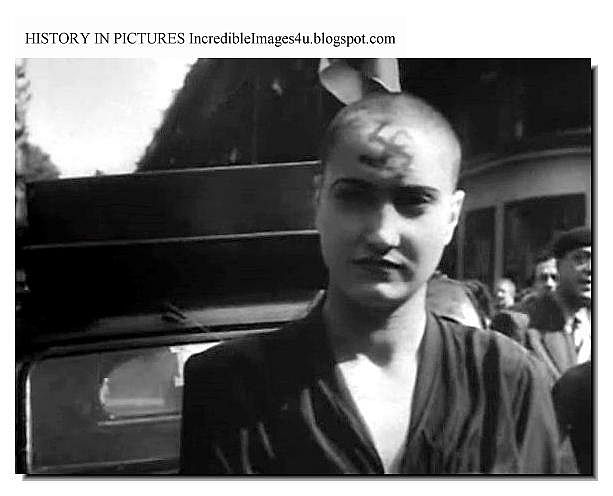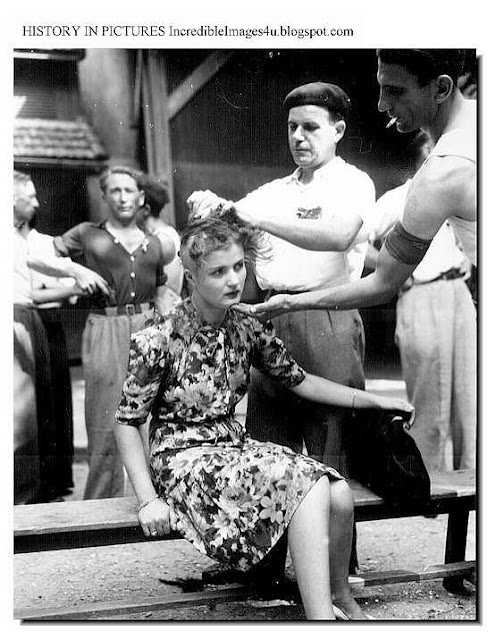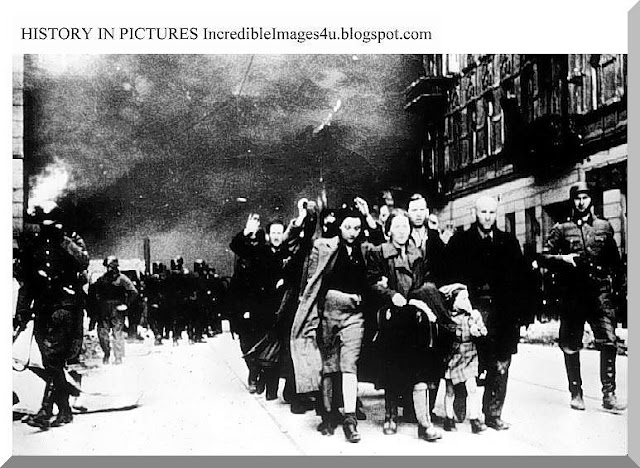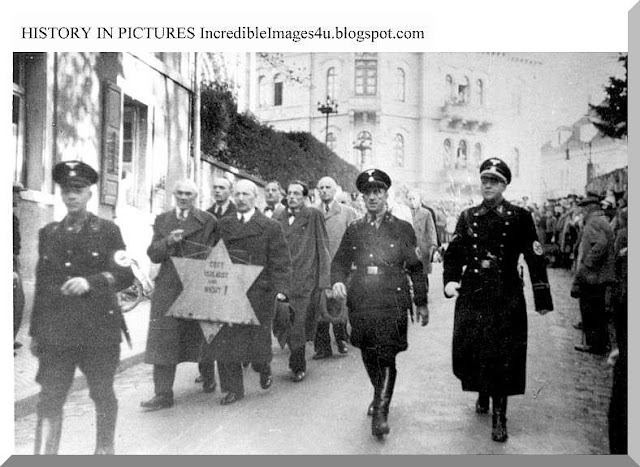 |
| Utter humility by Hitler as he bows before the WW1 legend Hindenburg: HITLER BECOMES CHANCELLOR OF GERMANY. 1933 |
HOW DID HITLER BECOME THE CHANCELLOR OF GERMANY IN1933?
Hitler's rise to power was based upon long-term factors - resentment in the German people, the weakness of the Weimar system - which he exploited through propaganda (paid for by his rich, Communist-fearing backers), the terror of his stormtroopers, and the brilliance of his speeches.
During the 'roaring twenties' Germans ignored this vicious little man with his programme of hatred. But when the Great Depression ruined their lives, they voted for him in increasing numbers. Needing support, and thinking he could control Hitler, President Hindenburg made the mistake in January 1933 of giving Hitler the post of Chancellor.
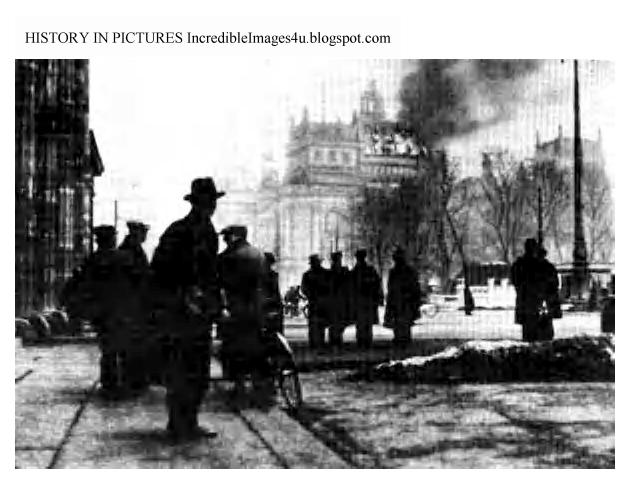 |
| The day Reichstag burned. It only tightened the grip of Hitler on Germany |
HOW THE NAZIS USED THE REICHSTAG FIRE
On February 27, Hitler was enjoying supper at the Goebbels home when the telephone rang with an emergency message:
“The Reichstag is on fire!” Hitler and Goebbels rushed to the fire, where they encountered Hermann Goering, who would later become Hitler’s air minister. Goering was shouting at the top of his lungs,
This is the beginning of the Communist revolution! We must not wait a minute. We will show no mercy. Every Communist official must be shot, where he is found. Every Communist deputy must this very day be strung up.
The day after the fire, the Prussian government announced that it had found communist publications stating,
Government buildings, museums, mansions and essential plants were to be burned down... . Women and children were to be sent in front of terrorist groups.... The burning of the Reichstag was to be the signal for a bloody insurrection and civil war.... It has been ascertained that today was to have seen throughout Germany terrorist acts against individual persons, against private property, and against the life and limb of the peaceful population, and also the beginning of general civil war.
So how was Goering so certain that the fire had been set by communist terrorists? Arrested on the spot was a Dutch communist named Marinus van der Lubbe. Most historians now believe that van der Lubbe was actually duped by the Nazis into setting the fire and probably was even assisted by them, without his realizing it.
Why would Hitler and his associates turn a blind eye to an impending terrorist attack on their national congressional building or actually assist with such a horrific deed?
Because they knew what government officials have known throughout history — that during extreme national emergencies, people are most scared and thus much more willing to surrender their liberties in return for “security.” And that’s exactly what happened during the Reichstag terrorist crisis. fff.org
VIDEO
 |
| The Reichstag fire gave the Nazis a pretext to arrest German communists |
THE GERMAN COMMUNISTS RESISTED HITLER'S RISE
Communists resisted Hitler by virtue of their political principles. In January 1933, the German Communist Party (KPD) had 300,000 members. With Hitler's seizure of power, they experienced a truly relentless persecution. In the wake of the Reichstag Fire Decree, which was based on a supposed Communist threat to the state, 10,000 KPD members were arrested. 14,000 more were arrested in 1935, 11,678 in 1936, over 8,000 in 1937 and 3,800 in 1938. By 1945 over half of Germany's Communists had been imprisoned or persecuted in some way. 25,000-30,000 of them had been murdered. To be a Communist in the Third Reich was clearly a high risk decision, and yet the hopes of many sympathisers remained alive. For example, the party set up anti-Nazi propaganda presses outside Germany. As a result 1.25 million pro-Communist leaflets were seized while being smuggled into Germany in 1934. During the next year 1.65 million were seized. Goodness knows how many more must have got through!
The group of young Communists led by Herbert Baum was, admittedly, a special case. Since all of its members were Jewish, they faced persecution regardless of their political beliefs, but still they managed to stage one of the most ambitious anti-Nazi stunts ever carried out on German soil. In 1942 Joseph Goebbels had opened an anti-Russian exhibition in Berlin entitled ironically 'The Soviet Paradise'. On 18 May, Baum and some friends fire-bombed the exhibition. Unfortunately it seems that one of the group was a police informer and soon they were arrested. Executions followed.
Source  |
| Hitler at Day of Potsdam |
DAY OF POTSDAM March 21, 1933
This pompous ceremony celebrated the opening of the Reichstag, which was elected on March 5, 1933, a month after Hitler became Chancellor. Hitler and Goebbels picked Potsdam, the old Prussian capital outside Berlin, as the venue. They chose March 21st because, 62 years earlier on that day, Otto von Bismarck had convened the first Reichstag of the "Second Reich." The entire event was broadcast on radio to present the Third Reich as the legitimate heir to the Kaiser's Reich and weaken objections to Hitler’s seizure of power.
stevenlehrer  |
| The Night of Long Knives |
WHAT WAS 'NIGHT OF THE LONG KNIVES'
The Night of the Long Knives, in June 1934, saw the wiping out of the SA's leadership and others who had angered Hitler in the recent past in Nazi Germany. After this date, the SS lead by Heinrich Himmler was to become far more powerful in Nazi Germany.
For all the power the Enabling Act gave Hitler, he still felt threatened by some in the Nazi Party. He was also worried that the regular army had not given an oath of allegiance. Hitler knew that the army hierarchy held him in disdain as he was 'only ' a corporal in their eyes. The Night of the Long Knives not only removed the SA leaders but also got Hitler the army's oath that he so needed.
By the summer of 1934, the SA's numbers had swollen to 2 million men. They were under the control of Ernst Röhm, a loyal follower of Hitler since the early days of the Nazi Party. The SA had given the Nazi's an iron fist with which to disrupt other political parties meetings before January 1933. The SA was also used to enforce law after Hitler became Chancellor in January 1933. To all intents, they were the enforcers of the Nazi Party and there is no evidence that Röhm was ever planning anything against Hitler.
However, Röhm had made enemies within the Nazi Party - Himmler, Goering and Goebbels were angered by the power he had gained and convinced Hitler that this was a threat to his position.
By June 1934, the regular army hierarchy also saw the SA as a threat to their authority. The SA outnumbered the army by 1934 and Röhm had openly spoken about taking over the regular army by absorbing it into the SA. Such talk alarmed the army's leaders.
Source  |
| A German poster proudly flaunts its expressways, the autobahn |
HITLER'S AUTOBAHN
The best possible way to bring the German people back into work is to set German economic life once more in motion through great monumental works... This is not merely the hour in which we begin the building of the greatest network of roads in the world, this hour is at the same time a milestone on the road towards the building up of the community of the German people.
-- Adolf Hitler
Perhaps best known throughout the world for its superior engineering and open stretches without a speed limit, the Autobahn was Hitler's invention from his dreams about an interstate highway system. Over 2000 km were built by 1938 and today approximately 11.000 km cover Germany. True to stereotypes about German engineering and maintenance, road designs are solid without a single pothole, with 4% or lesser grades, long acceleration and deceleration lanes, gentle curves, and free-resistant surfaces. Just as Hitler insisted on having buildings and other infrastructure that would last 1000 years, the engineers of the Autobahn design things right the first time and perform critical inspection and thorough maintenance to keep the best highway system in the world at peak operational performance.
 |
| The Nazis burn all 'dangerous' and 'useless' books |
VIDEO: NAZIS BOOK BURNING
WHY DID THE NAZIS BURN BOOKS IN 1933
On May 10, 1933, perhaps the most notable bonfire was the one that took place on Berlin's Opernplatz - Opera House Square -- opposite Humboldt University. This was the fruit of a month-long campaign by the German Student Association to "cleanse" German language and literature. The mission of these right-wing rabble rousers was in line with Joseph Goebbels's propaganda machinery on behalf of the Reich.
More than 20,000 books and journals, and about 5,000 images, all representing "insidious" Jewish influence, were torched by students and Nazi storm troopers. Enthusiastic crowds witnessed this feverish destruction of "un-German" writings which had been systematically pilfered from libraries, public buildings, private offices, and citizen's homes.
We know that similar "ceremonies" took place in some 30 German university towns. We know that torchlight parades were punctuated with speeches railing against "Jewish intellectualism" and calling for the purification of German culture. We know that writings by such Jewish intellectuals as Einstein and Freud fueled the flames, alongside German texts by Bertolt Brecht and Thomas Mann, and volumes by international writers including Dos Passos, Hemingway, Zola, Proust, and even Helen Keller.
 |
| Hitler at the 'decadent' art exhibition |
EXHIBITION OF DEGENERATE ART
In 1937 in Munich the Nazis held an art exhibition of what they called Entartete Kunst, or Degenerate Art. The purpose of the exhibition was to let the Germans know that some forms and pieces of art were not accepted by the "highest race", and this art is "degenerate", also called as Jewish or Bolshevistic. During the "Entartete Kunst" campaign over 20 thousand works by more than 200 artists of that time were confiscated.
The grounds for choosing the "unworthy" pieces of art were quite simple and cruel: anything that was out of tune with Hitler's way of thinking, was considered to be "degenerate". Hitler believed the art must serve the purpose of exaltation of the Aryan way of life. In this case, with this great aim, art is perfect and eternal. To Hitler's mind.
The authors of the banned works, mostly expressionists, were proclaimed mad. It would be curious to learn that most of those artists are known as the most prominent among their contemporaries, and are still admired. They are: Paul Klee, Wassily Kandinsky, Edvard Munch, many others, and the most degenerate artist of the world, Pablo Picasso.
This exhibition gave start to a series of art events in Germany of that time, and occurred to be a very powerful way of leading the overall opinion. The Nazis were good psychologists: instead of simply destroying the art works they thought inappropriate, they chose to do it publicly, in order not to create martyrs, so dearly loved by the people. In the way they did it, it worked, and the art of 1930s was labeled by the contemporaries as "incomprehensible and elitist".
 |
| Hitler's strength: Jugend. Hitler Youth |
HITLER JUGEND (YOUTH)
The Hitler Youth (Hitler-Jugend, HJ) was established by the Nazi party in 1926 to create a new youth-training system for young Germans to gain militarized training and develop their understanding and obedience to Nazi ideology.
Following the Nazi seizure of power other right-wing youth groups were merged into the HJ. From December 1, 1936 under the Jugenddienstpflicht all other youth groups were banned and their membership was merged into the Hitler Youth. HJ membership was made compulsory for youths over 17 in 1939 and for all over the age of ten in 1941. Von Schirach was replaced as leader by Arthur Axmann in 1940.
As the war progressed the group took on the work of men drafted into the armed forces, manned anti-aircraft defences and also produced many soldiers, especially for the Waffen SS, notably the 12th SS Panzer division under Kurt Meyer. As Germany was invaded members of the HJ were taken into the army at ever younger ages, during the Battle of Berlin in 1945 they were a major part of the German defences. The Hitler youth fought with great courage during the battle. One group of Hitler youth even managed to hold off a Soviet tank division for three days. Many soldiers said that no one scared them more then the Hitler youth. After the war the Hitler Jugend was dissolved and banned forever.
HITLER YOUTH VIDEOS
HITLER YOUTH TRAINING
 |
| That is what Nazi Germany expected from German women: Give birth to healthy white Nordic children |
ROLE OF WOMEN IN NAZI GERMANY
Women in Nazi Germany were to have a very specific role. Hitler was very clear about this. This role was that they should be good mothers bringing up children at home while their husbands worked. Outside of certain specialist fields, Hitler saw no reason why a woman should work. Education taught girls from the earliest of years that this was the lifestyle they should have.
From their earliest years, girls were taught in their schools that all good German women married at a young age to a proper German and that the wife’s task was to keep a decent home for her working husband and to have children.
One of the earliest laws passed by Hitler once he came to power in 1933, was the Law for the Encouragement of Marriage. This law stated that all newly married couples would get a government loan of 1000 marks which was about 9 months average income. 800,000 newly weds took up this offer. This loan was not to be simply paid back. The birth of one child meant that 25% of the loan did not have to be paid back. Two children meant that 50% of the loan need not be paid back. Four children meant that the entire loan was cleared.
The aim of the law was very simple - to encourage newly weds to have as many children as they could. There was also a more long term and sinister aspect to this : as Germany grew she would need more soldiers and mothers; hence a booming population was needed with young boys being groomed into being soldiers and young girls being groomed into being young mothers.
 |
| Hitler on the cover of TIME magazine |
 |
| Kristallnacht |
 |
| German troops enter Rhineland |
HOW THE MARCH INTO RHINELAND HAPPENED
Germany’s decision to move troops into the demilitarized Rhineland was a direct violation of both the Treaty of Versailles and the Locarno Pact. This agreement, to demilitarize the Rhineland, was forced upon the Germans after World War I with the Treaty of Versailles, and was later openly accepted as part of the Locarno Pact of 1925. This small piece of land was crucial to both the French and the Germans, for it allowed the French access to The Ruhr, which was the heartland of German industry. In early 1935 Hitler secretly begins plans to reoccupy the Rhineland, giving it the code name Schulung. For months following his decision to reoccupy the Rhineland, Hitler gives numerous deceiving speeches in which he affirms Germany’s commitment to upholding the terms agreed to in both the Treaty of Versailles and the Locarno Pact. Meanwhile the French government observes that German troops and war planes were moving closer, and inside information suggested that the Germans were planning to move into the Rhineland soon.
By the Fall of 1935 the French decide that it is crucial that they decide their official position concerning the defending the Rhineland. The French leaders concluded that British support was crucial in their decision because without British support the French were not confident fighting the Germans. After an indecisive response from the British the French were forced to make the decision on their own. The French army was not prepared to attack the Germans, but they hesitantly agreed to defend the Rhineland if it was invaded by German troops. The indecision lasted until mid February of 1936 when French Foreign Minister Flandin suggests that a formal complaint be made to the League of Nations once the Germans chose to invade the Rhineland.
Disagreements soon arise in the French government, causing much tension in the officers in charge of defense. Many hypothetical situations were discussed, including a deal that would allow the Germans to occupy the Rhineland as long as they agreed to not stockpile arms or build permanent structures. Still, the French fail to agree on a plan of defense and they continue their policy of "no action".
Finally on March 7, 1936 German troops receive orders to move into the Rhineland. Strategically planned for a Saturday, Hitler causes mass confusion in the French defense department because the French are unable to confer with British government officials who traditionally leave London for the weekend to spend time in their country homes, where they can not be contacted. Initially the French do nothing to stop the Germans while the French Ambassador to France, Flandin, frantically attempts to contact members of the British government on a Saturday afternoon, but his hopes were in vain, as the British wanted to delay involvement for as long as possible, forcing the French to make a decision by Sunday morning.
The French were reluctant to fight the Germans for numerous political and military reasons. The French generals, led by Army Chief Gamelin, were not confident with fighting the Germans alone and this fear caused them to recommend that the French do nothing in the Rhineland. The French people were also reluctant to become involved in another war with Germany, as many still remembered the horrors of World War I twenty years earlier. And with elections just weeks away many government officials up for re-election in France were worried that any false move regarding such a hotly debated political issue would cause them to lose their election. Flandin appeared to be the only member of Premier Sarrat’s advisory board who advocated the use of troops to defend the Rhineland, but he was overruled by the other leader’s who feared any sort of decisive action. Ironically, the German troops sent to the Rhineland were unequipped for battle, and received orders to immediately retreat at the first sign of French troops, but due to France’s passive methods of handling the situation, Hitler’s gamble allowed him to reoccupy the Rhineland without conflict.
 |
| Hitler enters Austria after the Anschluss |
EVERYTHING ABOUT THE ANSCHLUSS
In March of 1938, after the annexation of Austria by Germany (known as the Anschluss), German officers marched into Austria. This change, which was more of an absorbing of Austria into Germany than an equal unification, lasted until the end of World War II in 1945.
Why Did Germany Take Over Austria?
Germany became a dictatorship in 1933, when Adolf Hitler became chancellor. Hitler openly defied the terms of the Treaty of Versailles, which stated that Germany was not to acquire new territory or build up its military. Hitler, originally from Austria, saw the opportunity to take over Austria as beneficial to his plan of a German Reich (empire).
Did Austrians Support the Anschluss?
It would be nice to imagine a scene similar to the one in the classic Hollywood film, The Sound of Music, where Captain von Trapp starts singing "Edelweiss," and Austrians, to the annoyance of the Nazi officers in the audience, join in. In reality, however, public opinion of the Anschluss was nowhere near that sort of opposition.
Austrians, in general, were very much in favor of Anschluss. They saw it as being economically advantageous (even vital) for the country. When the Germans marched into cities like Salzburg, the Austrians greeted them with open arms, waving Nazi flags and holding up pictures of Hitler.
Devastating Effects of the Anschluss
On November 9-10, 1938, Nazi forces known as the Sturmabteilung (SA) smashed windows of synagogues, shops and other businesses owned by Jews, and even homes. The SA burned synagogues throughout Germany, Austria, and the recently invaded Sudetenland in Czechoslovakia.
This horrific pogrom was known as Kristallnacht, or the Night of the Broken Glass. Deportations of Jews began, and many fled Austria during the winter of 1938-39. Concentration camps, including Mauthausen-Gusen, were built in Austria not long after the Anschluss, where many were worked to death and murdered until 1945.
Pockets of Resistance Prior to, During, and After the Anschluss
Though an overwhelming percentage of Austrians supported the Anschluss, there were some, particularly small groups of young Catholics, who did oppose it, or at the very least opposed the politics of the Nazi party. Some resistance did occur in Austria throughout the first years of the Anschluss up until the end of the Second World War, but there was never a single mass, highly organized movement.
VIDEO: ANSCHLUSS, UNION WITH AUSTRIA
 |
| Hitler looking very reasonable at Munich. He fooled Chamberlain |
THE MUNICH AGREEMENT, 1938
Ever since Hitler came to power in 1933 he had made successive assaults on the restrictions that had been placed on Germany by the Treaty of Versailles. He had begun secretly the process of rearmament and felt confident enough to announce the program in 1935, the same year in which he introduced conscription to the new German army.
Encouraged by England's acquiescence in German naval expansion, he next remilitarized the neutral Rhineland zone. Two years later, with the annexation of Austria, the Treaty was well and truly buried. Yet despite his reassuring falsehoods over the years since 1933--"We will never attempt to subjugate foreign peoples," "We have no territorial claims to make in Europe," and the like--by the summer of 1938 he had begun a propaganda campaign against Czechoslovakia, ally of both France and Russia, in the matter of the 3 million or so ethnic Germans in the Sudeten region of that country, a former territory of the defunct Austrian empire. Lurid threats were hurled by the Nazi propaganda machine against the alleged mistreatment of their minority Germans; the excuse for the contemplated destruction of Czechoslovakia, a state unjustifiably dubbed by Hitler as 'a Bolshevik aircraft carrier in the heart of Europe'.
During the summer the pro-Nazi elements among the Czech Germans demanded to secede from Czechoslovakia, a move that, in the absence of support from their allies or Great Britain, the Czecks could not resist. The result- -a clear example of the workings of appeasement (of which the British prime minister Neville Chamberlain, shown here upon his return from Munich with the scrap of paper that was to "ensure peace in our time"!), was the hopeful exponent) in the attempt to prevent hostilities--was the Munich Agreement, generally regarded as the shameful culmination of the Allied refusal (and inability at that time) to confront Nazi aggression.
Source  |
| The naked Nazi aggression seen. German soldiers removing the barrier to enter Poland. September 1, 1939 |






